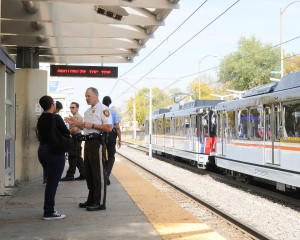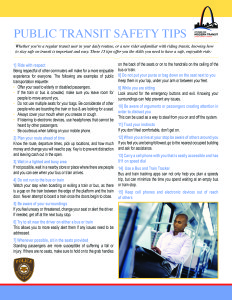 Using public transportation is an easy way to travel. Below you will find information about how to use public transportation, along with safety guidelines and etiquette tips.
Using public transportation is an easy way to travel. Below you will find information about how to use public transportation, along with safety guidelines and etiquette tips.
Transit Riding P’s & Q’s go a long way to creating a more enjoyable ride for all . . .
Being respectful of your fellow commuters will make for a more enjoyable experience for everyone. The following are examples of public transit ‘do’s’:
- Offer your seat to elderly or disabled passengers.
- If the train or bus is crowded, make sure you leave room for people to move around you. (Don’t block the door!)
- Avoid using the phone as much as possible.
- Do not use multiple seats for your bags or for reclining. Be considerate of other people who are boarding the train or bus and are looking for a seat.
- Always cover your mouth when you sneeze or cough.
- If listening to music, use headphones that cannot be heard by other passengers or be sure to keep the volume at a reasonable level.
 Knowing how to ride transit safely adds to the enjoyment of the ride. . .
Knowing how to ride transit safely adds to the enjoyment of the ride. . .
One of the benefits of public transportation is that it’s a safe way to travel. Whether you’re a regular transit rider or a new rider unfamiliar with using transit, knowing how to ride safely is important and easy. Here are some tips to ease you into a safe, enjoyable ride:
1. Ride with respect
Being respectful of other commuters will make for a more enjoyable experience for everyone.
2. Plan your route ahead of time
Know the route, departure times, pick up locations, and how much money and change you will need to pay. Key is to prevent distraction and avoid leaving cash out in the open.
3. Wait in a lighted and busy area
If not possible, wait in a nearby store or place where there are people and you can see when your bus or train arrives.
4. Do not run to the bus or train
Watch your step when boarding or exiting a train or bus, as there is a gap on the train between the edge of the platform and the train door. Never attempt to board a train once the doors begin to close.
5. Do not put your purse or bag down on the seat next to you
Keep them in your lap, under your arm or between your feet.
6. Know your surroundings
Look around for the emergency buttons and exit. Knowing your surroundings can help prevent any issues.
7. Be aware of arguments or passengers creating attention in order to distract you
This can be used as a way to steal from you on and off the system.
8. When you arrive at your stop be aware of others around you
If you feel you are being followed, go to the nearest occupied building and ask for assistance.
9. Carry a cell phone with you that is easily accessible and has 911 on speed dial
10. Use a Bus and Train Tracker
Bus and train tracking apps can not only help you plan a speedy trip, but can minimize the time you spend waiting at an empty bus or train stop.
11. Keep cell phones and electronic devices out of reach of others
12. Be aware of your surroundings
If you feel uneasy or threatened, change your seat or alert the driver. If needed, get off at the next busy stop.
13. Try to sit near the driver on either a bus or train
This allows you to more easily alert them if any issues need to be addressed.
14. Whenever possible, sit in the seats provided
Standing passengers are more susceptible of suffering a fall or injury. If there are no seats, make sure to hold on to the grab handles.
Downloadable Public Transit Safety Tips